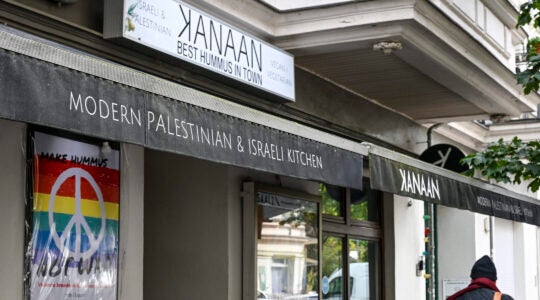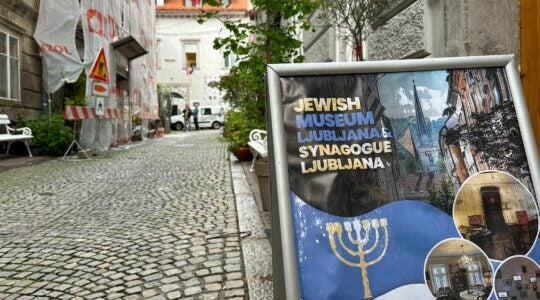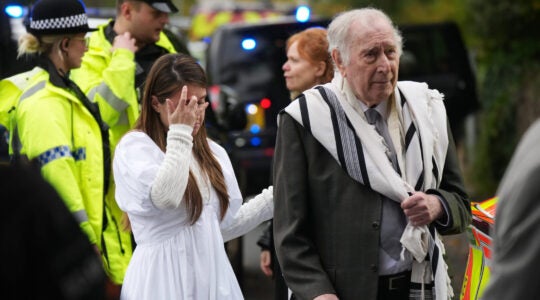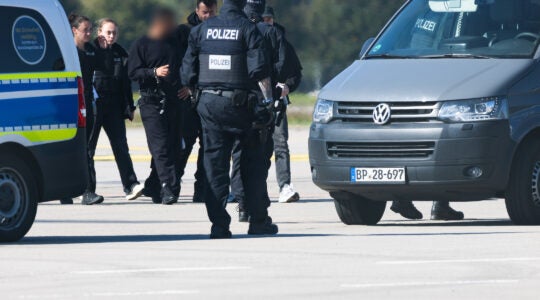PRAGUE (JTA) – With several hundred neo-Nazis preparing to descend upon Prague’s Jewish quarter for a brazen march on the anniversary of Kristallnacht, Prague’s small Jewish community found some unusual allies: anarchists, a Muslim leader and thousands of non-Jewish Czechs.
On a freezing Sabbath afternoon that marked the 69th anniversary of the Night of Broken Glass, the neo-Nazis got the boot in the Czech capital — literally, in some cases.
Thousands of Czechs filled the streets Saturday to protest the neo-Nazis in an unusually large and emotional show of solidarity with the country’s Jews that in some cases turned violent.
Masses of non-Jews marched through the streets, many wearing yellow Stars of David inscribed with the word “Jude,” while a few anarchists clashed with neo-Nazis in bloody street fights. The anarchists kicked and stomped two neo-Nazis until they lay dripping with blood in front of the Charles University Law School.
The violence notwithstanding, the Czech Jews and non-Jews said they were inspired by the massive turnout against the neo-Nazi extremists, who had scheduled their march for the Jewish quarter but were barred from the neighborhood by a court ruling.
The neo-Nazis said they would march anyway, but some 1,400 police prevented the several hundred who came from entering the city center.
“We are told about ‘Never again,’ ” said Alena Hladkova, 33, a non-Jew who on Saturday found herself waving an Israeli flag in front of the Prague Jewish community’s headquarters. “But unless you are ready to defend that, it doesn’t mean anything.”
Saturday’s events marked the first time in recent memory that residents of a former Eastern bloc capital took to the streets in large numbers to demonstrate against anti-Semitism. Observers hailed it as a milestone and said the demonstrations should serve as a model for responding to neo-Nazis elsewhere in Eastern Europe.
“This is a turning point for Czech civil society,” said Gert Weisskirchen, a member of Germany’s parliament and the Organization for Security and Cooperation in Europe’s special representative against anti-Semitism.
“After the Velvet Revolution, society was a bit quiet. But today Czechs showed loudly and publicly that neo-Nazis have no chance here.”
The grass-roots Czech participation in the day’s events, Weisskirchen said, should serve as a model for Hungary, Romania and Bulgaria, where right-wing extremist groups have formed national guards or gained seats in parliament.
Only about 1,500 Jews live in Prague, but some 3,000 to 4,000 demonstrators turned out for the day’s events. They included a prayer service in front of the Old-New Synagogue, a march through the Old Town where the Jewish quarter is located, musical performances and presentations by Holocaust survivors that were projected on a large outdoor screen.
On the day after the demonstrations, a former Czech interior minister, Frantisek Bublan, who once was a Catholic priest, wore a yellow Star of David on his lapel during an interview on the country’s most watched TV news show.
The massive outpouring of support extended even to leaders of the country’s Muslim and Gypsy communities, who publicly expressed support for the Jews ahead of the planned neo-Nazi march.
The Young National Democrats — a group anti-racism advocates say is a front for the National Resistance, a well-known international neo-Nazi organization — had scheduled the original march.
Experts estimate that there are less than 1,000 active neo-Nazis today in the Czech Republic. However, as is the case across Europe, neo-Nazis increasingly are using the Internet to network and create more international gatherings.
About 600 neo-Nazis from Germany, Slovakia and Poland were expected to march in Prague on the anniversary of Kristallnacht, when the Nazis led brutal attacks on Jews and Jewish property in Germany and Austria.
Their march never materialized, however, as police blocked the neo-Nazis at metro stops and sealed off the Jewish quarter.
The few dozen neo-Nazis who managed to make it to the perimeter of the Jewish quarter were attacked by anarchists and anti-fascists.
Police in riot gear, on horseback and armed with water cannons blocked about 1,500 to 2,000 of the anti-fascist marchers. Some sought to demonstrate peacefully while others, especially anarchists, went looking for neo-Nazis to beat up.
One Czech Jew who survived a Nazi concentration camp said she was buoyed by the sight of her fellow citizens standing up for her.
“Two weeks before this day I couldn’t sleep and had terrible dreams,” said Zuzana Ruzickova, who survived Terezin. “It’s something extraordinary to see so many people come and support the Jewish community.”
On the Old Town Square, Mayor Pavel Bem addressed thousands during a ceremony sponsored by the Jewish Liberal Union.
“We need to cultivate the national memory to avoid what happened in the past,” he said.
The Nazis murdered 80,000 of Czechoslovakia’s 120,000 Jews during World War II.
Tomas Homula, 43, was among the Jews who marched to the city’s famed Old-New Synagogue wearing the yellow Star of David. Homula, who brought his 14-year-old daughter, is the son of a Holocaust survivor.
“We are not afraid today to show the extremists they are unwelcome,” Homula said. “We wear this star today with pride and not with fear.”
A young Israeli watching the spectacle Saturday of black-masked anti-fascist protesters taking over glitzy Pariszka Street shouted, “Jews 1, Nazis 0.”
JTA has documented Jewish history in real-time for over a century. Keep our journalism strong by joining us in supporting independent, award-winning reporting.





